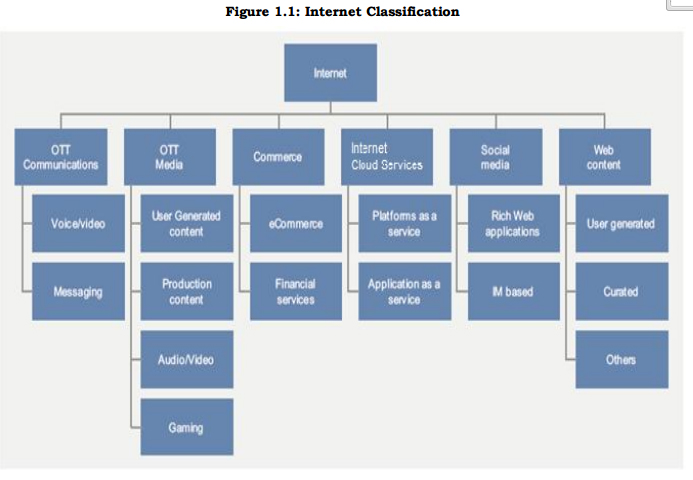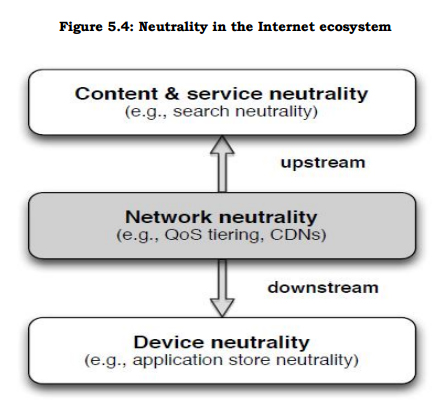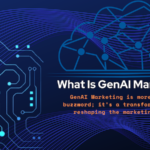The Telecom Regulatory Authority Of India (TRAI) published a Consultation Paper On Regulatory Framework for Over-the-top (OTT) services on 27th March, 2015.
The objective of this Consultation Paper (CP) was to analyse the implications of the growth of OTTs and consider whether or not changes are required in the current regulatory framework
Telecom service providers (TSPs) offering fixed and mobile telephony are currently being overwhelmed by online content, known as over-the-top (OTT) applications and services. The term over-the-top (OTT) refers to applications and services which are accessible over the internet and ride on operators’ networks offering internet access services e.g. social networks, search engines, amateur video aggregation sites etc. The best known examples of OTT are Skype, Viber, WhatsApp, Chat On, Snapchat, Instagram, Kik, Google Talk, Hike, Line, WeChat, Tango, ecommerce sites (Amazon, Flipkart etc.),Ola, Facebook messenger, Black Berry Messenger, iMessage, online video games and movies (Netflix, Pandora).
It is becoming increasingly difficult for consumers to know if there is an economic difference in connecting various networks via a land phone, cell phone, or a computer. In fact, young users find it difficult to distinguish among these three networks; from their perspective, all that matters is connectivity. They visualize these not as a layered and interconnected series of discreet networks, but as an organic whole.
Carriage is separated from content in internet networks, enabling OTT content and application service providers to deal directly with end users. TSPs are excluded from the said transactions, with no control over the content or the application. The characteristics of OTT services are such that TSPs realise revenues solely from the increased data usage of the internet-connected customers for various applications (henceforth, apps).
The TSPs do not realise any other revenues, be it for carriage or bandwidth. They are also not involved in planning, selling, or enabling OTT apps. On the other hand, OTT providers make use of the TSPs’ infrastructure to reach their customers and offer products/services that not only make money for them but also compete with the traditional services offered by TSPs. Leave aside TSPs, these apps also compete with brick and mortar rivals e.g. e-commerce sites, banking etc. Currently, the major sources of internet traffic are Google, Yahoo, MySpace, YouTube, Facebook, Windows Live, eBay, Wikipedia.org, msn.com and Craigslist, in that order.
These portals are not owned by the networks are capturing millions of user connectivity hours. Apart from web content and social media, OTT communications and OTT media are now increasingly playing a major role in the internet domain. The affordability of smartphones (because of declining price) and the upgradation of access networks by the TSPs are among the important factors contributing to OTT growth. Digitalization of content has reduced conservation, reproduction and distribution costs, which, in turn, has promoted the explosive growth in the supply of online content.
The growth of traffic apart, the OTT applications have created an increasing demand for faster broadband speed, which translates into a need for huge investments in network up-gradation by the TSPs. It is thus becoming clear that, in future, the provision of services by OTT players will impact revenues of network operators insofar as their current business models are concerned. This has already started happening in some developed countries. And, these developments have implications for the Operations Support System and Business Support System (OSS/BSS) of the communication systems used by the TSPs to support end-to-end telecom services.
The public internet that started in the 1980s has grown in scope over the last three decades. In its current form, it has the added ability to carry the entire gamut of services that are required to be delivered to a consumer of telecom services. It allows a telecom subscriber to access almost all the services required for information, education and entertainment.
What is Net Neutrality (NN)?
Net neutrality (NN) is generally construed to mean that TSPs must treat all internet traffic on an equal basis, no matter its type or origin of content or means used to transmit packets. All points in a network should be able to connect to all other points in the network and providers should be able to deliver traffic from one point to another seamlessly, without any differentiation on speed, access or price. The principle simply means that all internet traffic should be treated equally.
In USA, FCC has defined Network, or "net" neutrality as another way to refer to open internet principles. The open internet is the internet where consumers can make their own choices about what applications and services to use, and where consumers are free to decide what content they want to access, create, or share with others.
Currently, NN is a topic of great debate across the world. At one level, it is being linked to the right to freedom of expression and the right to information. The underlying idea of an open internet is that all internet resources and the means to operate on it are easily accessible to all. It effectively renders the network carrier a dumb pipe i.e. intelligence of management and operation of communication must lie at the end points of the network and not in the network.
It has been suggested that to ensure a thriving and neutral Internet, the following issues need to be addressed:
- The Internet must be kept open and neutral. Reachability between all endpoints connected to the Internet, without any form of restriction, must be maintained.
- All data traffic should be treated on an equitable basis no matter its sender, recipient, type, or content. All forms of discriminatory traffic management, such as blocking or throttling should be prohibited.
- Network service providers should refrain from any interference with internet users’ freedom to access content (including applications of their choice)
- There should be restricted use of packet inspection software (including storage and re-use of associated data) to control traffic.
- Complete information on reasonable traffic management practices and justifications for the same must be accessible and available to the public. TSPs should be transparent and accountable to any changes in practices.
- Non-neutral treatment of traffic for “voluntary” law enforcement purposes must be prohibited unless there is a legal basis for it.
According to the “THE ECONOMIST”, January 31, 2015
NET NEUTRALITY Net neutrality is a slippery concept. The term, coined by Tim Wu underlies the basic principle that has led to the success of internet- businesses that operate the network may not discriminate between different data packets. This ensures that innovators or content developers do not need to ask permission for new projects, making internet a collection of a large amount of information, analysis, opinions and services with no sole content provider or regulator.
However, with the internet becoming more crowded and improvement in traffic management tools, net neutrality is difficult to sustain. These new technologies allow the network operator to identify the traffic they are transmitting and scrutinizing, stopping or slowing down spam and other such traffic. Network operators can now create lanes of different speeds to not only manage their traffic, but make more profits.
The question that needs to be answered is that who will pay these profits- the consumers or the content providers owning majority traffic? Why should capacity-hungry services like those sites that stream videos not pay when they take up majority of the traffic capacity, especially when they are earning from it? On the other hand, many argue that without net neutrality laws, toll booths and check points will spring up all across the network, making it less attractive to new content providers and developers.
They fret that network operators will abuse their market power for maximizing profits. This might, in the long run, impinge upon the freedom to impart and receive information without any interference. The operators on the other hand argue that the increasing internet traffic can sustained by investments in upgradation of networks which will be possible by increase in profits. The recent Latvian proposal allows paid fast lanes, “provided that sufficient network capacity is available so that the availability and general quality of internet access services are not impaired in a material manner”. The next network neutrality debate is over ‘zero-rating’, i.e. customer access to certain websites without charging them for data usage.
This will, some argue is a great way to allow customers to access these services. However, who will choose these sites and on what basis- learning basis or on popularity? This will make it difficult for competitors to compete and benefits a particular company by creating its monopoly in the service. Regulators in Slovenia and Netherlands recently banned certain forms of zero-rating. Micro-regulation can lead to adverse impact in the industry, and detailed rules and utility- type regulations might not be the correct approach. Broader rules, such as insisting that a provider’s basic services must not be very slow can be a better option. Competition between network providers will also lead to better services and reduce exploitation of market power.
You can download the full consultaion paper on
http://www.trai.gov.in/WriteReaddata/ConsultationPaper/Document/OTT-CP-27032015.pdf
April 17, 2015





